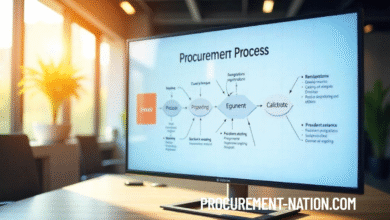Procurement Definition: Heart of Modern Business Operations

In the worldwide dynamic of employers, overall performance and price control are vital keys to success. At the center of every lies a middle characteristic: procurement. While regularly used interchangeably with phrases like shopping or sourcing, procurement is far more strategic and important to long-term organizational health. In this article, we’ll discover the genuine procurement definition, its role in business enterprise, the strategies involved, and how contemporary procurement practices affect organizational fulfillment.
What is Procurement Definition?
Procurement refers to the process of acquiring goods, services, or works from external sources, often through a formal process involving purchasing, contracting, and supplier management.
Procurement entails the entirety from sourcing companies to negotiating contracts and dealing with ongoing provider relationships. Unlike sincere shopping, which generally specializes in shopping for, procurement is a broader, extra strategic function that includes studies, planning, and optimization.
In most companies, procurement serves as a bridge between operations and suppliers, making sure the proper gadgets or services are received at an exceptional price, on time, and in compliance with internal and external standards.
Procurement vs. Purchasing: Is There a Difference?
Although the terms “procurement” and “shopping” are frequently used interchangeably, they refer to different processes.
| Aspect | Procurement | Purchasing |
|---|---|---|
| Definition | The overall process of acquiring goods and services. | The specific act of buying goods and services. |
| Scope | Broader, includes strategic planning, supplier selection, contract negotiation, and more. | Narrower, focuses mainly on the transactional process of ordering and receiving goods. |
| Process Involvement | Involves strategic analysis, vendor relationship management, and negotiation. | Involves ordering, invoicing, and receiving products or services. |
| Objective | To ensure the right products are acquired at the right time and cost, considering long-term benefits. | To obtain the products or services requested at the best possible price. |
| Time Frame | Long-term, continuous process. | Short-term, transactional. |
| Key Activities | Identifying needs, market research, negotiating contracts, managing supplier relationships. | Issuing purchase orders, receiving goods, processing payments. |
| Focus | Focuses on the overall supply chain management. | Focuses specifically on the buying process. |
| Decision-making | Involves high-level decisions regarding sourcing and strategy. | Involves operational decisions related to day-to-day purchases. |
| Role | Strategic, ensuring the alignment of procurement with organizational goals. | Tactical, ensuring the purchase is executed efficiently. |
Key Stages in the Procurement Process
The procurement process involves numerous essential steps. While proper steps can also vary based on industry or commercial enterprise size, here’s an ordinary way:
1. Identifying Needs
Procurement begins when a branch or organization acknowledges the need for goods, substances, or offerings. This may need to vary from workplace materials to raw substances or outsourced offerings.
2. Specifying Requirements
Next, the crew outlines the suitable specs of what they need. This may additionally include quantity, wonderful, shipping time limits, technical capabilities, or compliance necessities.
3. Supplier Research and Selection
The procurement group researches potential suppliers, compares their offerings, examines certifications, and can problem a Request for Proposal (RFP) or Request for Quotation (RFQ).
4. Negotiation and Contracting
Once a supplier is chosen, the terms of the engagement pricing, timelines, SLAs, and charge phrases, are negotiated and formalized in a legally binding agreement.
5. Purchase Order and Delivery
After contracts are signed, a buy order (PO) is issued. The provider grants the products or services as agreed.
6. Receiving and Inspection
Deliveries are inspected for pleasant and accuracy. Any discrepancies are addressed in advance of shifting to the following level.
7. Invoice Approval and Payment
The procurement or finance group evaluates the bill against the PO and shipping receipt. Once confirmed, the price is processed.
8. Supplier Performance Evaluation
Post-purchase, the issuer’s overall performance is evaluated. Strong relationships are nurtured, and underperforming companies can be changed.
Each degree enables higher transparency, duty, and rate for the corporation, it is truly why having an established procurement approach is essential.
Types of Procurement
Understanding the styles of procurement lets groups streamline operations. Here are the principal instructions:
- Direct Procurement: This refers to the acquisition of raw materials, components, or items that are probably reused right away within the corporation’s service or product shipping. For instance, a bakery purchases flour or sugar.
- Indirect Procurement: This includes goods or offerings that resource operations, however, don’t without delay make contributions to stop production, including of place of work materials, upkeep services, or software.
- Goods Procurement: Focuses on tangible devices inventory, machinery, devices, and so on.
- Services Procurement: Covers obtaining services such as consulting, prison services, schooling, or advertising and marketing.
Each type requires a barely exclusive approach but falls under the wider procurement definition.
Why Is Procurement Important in Business?
Procurement is more than just a middleman, it’s a strategic characteristic that drives overall performance, profitability, and innovation. Here’s why procurement topics:
Cost Savings
Effective procurement strategies can substantially reduce operational expenses via securing higher fees, lowering waste, and enhancing supply phases.
Quality Control
A dependent procurement system guarantees that materials or offerings meet the specified necessities, retaining the best of final products.
Risk Management
Procurement experts are skilled to mitigate dangers related to supply chain disruptions, vendor reliability, and compliance issues.
Strategic Vendor Relationships
Strong company relationships result in higher profits, precedence, and collaborative innovation.
Operational Efficiency
Procurement guarantees that departments get preserve of what they need on time, heading off delays in manufacturing or issuer delivery.
What Is Strategic Procurement?
Strategic procurement is the evolution of traditional procurement right into an in, questioning, cost-driven process. It includes:
- Long-term planning
- Total price of ownership analysis
- Supplier development programs
- Category management
- Alignment with corporate desires
Strategic procurement turns sourcing right into an aggressive gain in preference to an operational characteristic. Companies embracing this version frequently attain higher profitability, higher provider overall performance, and more potent market positioning.
Role of Technology in Modern Procurement
Technology is reworking the procurement landscape. Digital equipment enhances visibility, overall performance, and decision-making. Common equipment consists of:
- Procurement Software: Platforms like SAP Ariba, Coupa, Oracle Procurement Cloud, and GEP SMART automate the whole procurement lifecycle.
- E-Procurement: Electronic procurement structures allow for real-time purchase order technology, approvals, and provider management online.
- Data Analytics: Advanced analytics help procurement groups understand spending patterns, look at supplier average performance, and forecast demand.
- AI & Automation: Machine learning and AI are used for name prediction, fraud detection, and workflow automation.
Incorporating generation into procurement not handiest reduces guide errors but also helps smarter decision-making and real-time collaboration.
Common Procurement Challenges
Despite its importance, procurement comes with its own non-public set of demanding situations:
- Supplier delays and unreliability
- Budget overruns due to negative forecasting
- Compliance and regulatory risks
- Lack of visibility in some point of departments
- Manual and paper-based techniques
- Poor records for decision-making
Companies that fail to undertake a robust procurement machine regularly face operational inefficiencies, customer dissatisfaction, and monetary losses.
How to Improve Your Procurement Process
Improving procurement begins with readability. Here are hints to streamline your procurement strategy:
- Define clear procurement policies and workflows
- Use procurement software to automate responsibilities
- Train groups on negotiation and agreement control
- Establish KPIs to screen procurement performance
- Build robust, long-term dealer relationships
- Encourage inter-departmental collaboration
A strong procurement technique aligns with agency desires and allows for sustained increase.
Conclusion
Understanding the proper procurement definition is key to running a fulfillment, cost-effective, and compliant business enterprise. It’s not pretty, a great deal of searching for its approximately strategic sourcing, risk management, cost creation, and operational excellence. Businesses that cope with procurement as a central feature in the vicinity of a back-office venture are more likely to outperform their opposition.
In these globalized and tech-driven markets, procurement experts play an essential role in steering their businesses through complex supply chains and financial uncertainty. Whether you are a small commercial corporation or a worldwide organization, studying procurement offers you a clean competitive component.
So, the following time you consider procurement, suppose past shopping for. Think method. Think cost. Think increase.




2 Comments